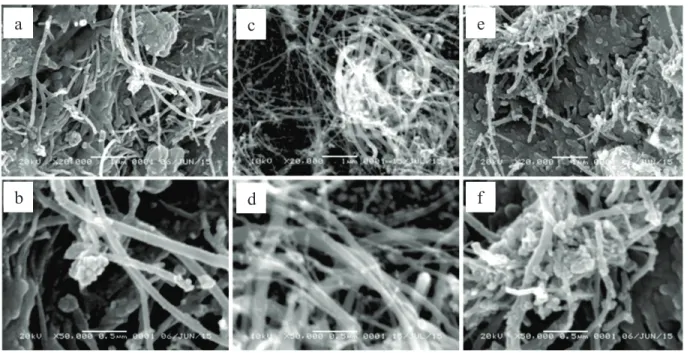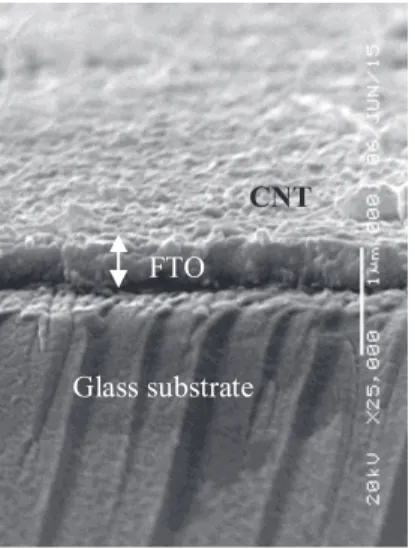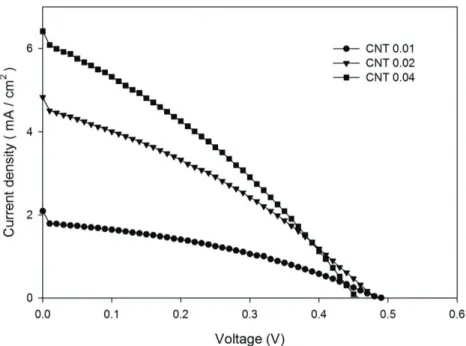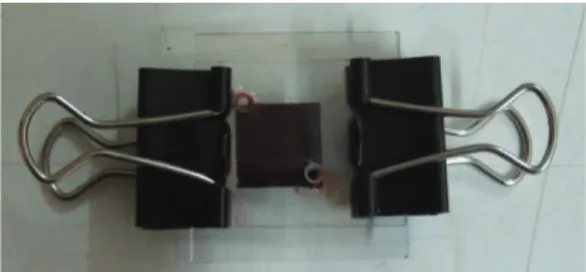Abstract. The counter electrode using Carbon nanotubes (CNT) has been successfully fabricated using doctor blade method and their performance was investigated. The results suggest that the CNT counter electrode has potential as an alternative to the free Pt counter electrode for DSSC. The CNT powder, which was prepared using the spray pyrolysis method as previously reported by Subagio et al., was used as the counter electrode layer material.
After drying at 80oC for 5 minutes, the CNT counter electrode was annealed at 450oC for 1 hour. The active area of the working electrode and the counter electrode was determined to be 1 x 1 cm 2 . The density of the CNT was increased because there is more CNT in the binder, which favors the electron transfer from the counter electrode to the electrolyte interface [21]. The one-dimensional structure of the CNTs helps them to make good electrical conductivity [22]. ,23].
However, given the low cost and high electrocatalytic activity of the CNT counter electrode, it should be a competitive alternative to the Pt-free counter electrode for DSSC. 34;A MoS2/graphene flake catalytic composite film as a counter electrode for Pt-free, dye-sensitive solar cells", Electrochimica Acta, 2012. 34;Carbonaceous materials and their progress as a counter-electrode in dye-sensitive solar cells: challenges En.
34;CNT/PEDOT core/shell nanostructures as a counter electrode for dye-sensitized solar cells", Synthetic Metals, 2011.

Instructor
The counter electrode using Carbon nanotubes (CNT) has been successfully fabricated using doctor blade method and their performance was investigated. We found that increasing mass of the CNT powder in the binder increases the electrocatalytic activity, which is beneficial to the conversion efficiency of the Dye-Sensitized Solar Cell (DSSC). Facile synthesis and characterization of two-dimensional SnO 2 -decorated graphene oxide as an effective counter electrode in DSSC Mahmoud, M.S.
Low Temperature Growth of Carbon Nanotubes Using a Chemical Bath Deposited Ni(OH)2 - An Efficient Pt-Free Counter-E Electrode for Dye-Sensitized Solar Cells. Nanoarchitectures in Dye-Sensitized Solar Cells: Metal Oxides, Perovskite Oxides, and Carbon-Based Materials Shaikh, J.S. Set quote alert ▻ ▻ Set quote feed. A low-cost, high-efficiency solar cell based on dye-sensitized colloidal TiO films2 Cited 22603 times. http://www.nature.com/nature/index.html.
Analysis of electron transfer properties of ZnO and TiO dye photoanodes. http://www.elsevier.com/locate/jphotochemrev. Preparation of high-transmittance platinum counter electrode at an ambient temperature for flexible dye-sensitized solar cells. Several highly efficient catalysts for Pt-free and FTO-free counter electrodes of dye-sensitized solar cells.
A platinum counter electrode with high electrochemical activity and high transparency for dye-sensitized solar cells. Non-Pt counterelectrode catalysts using tantalum oxide for low-cost dye-sensitized solar cells. A new WO nanorod catalyst for the counter electrode of dye-sensitized solar cells2 cited 288 times.
Preparation and characterization of carbon-based counter electrodes made by electrophoretic deposition for dye-sensitized solar cells. Water-soluble polyelectrolyte-grafted, multi-walled carbon nanotube thin films for efficient counter electrode of dye-sensitized solar cells.
PRELIMINARY
PLENARY AND INVITED PAPERS
6TH NANOSCIENCE AND NANOTECHNOLOGY SYMPOSIUM (NNS2015)
Structure and properties of solid polymer electrolyte based on chitosan and ZrO nanoparticles for lithium-ion battery.
CONTRIBUTED ORAL PAPERS
The optical properties and photocatalytic activity of CdS-ZnS-TiO/Graphite for isopropanol degradation under visible light irradiation. The influence of reduced graphene oxide on electrical conductivity of LiFePO-based composite as cathode material. The effects of molar composition of strontium (x) on the properties of barium strontium titanate (BaSrTiO) prepared by the solid state reaction method.
Synthesis of gadolinium carbonate-conjugated-poly(ethylene) glycol (Gd (CO ) @PEG) particles via a modified solvothermal method. Investigation of characteristics of PVDF/nano-clay composite polymer electrolyte using PVP as pore-forming agent. Solution of D-dimensional Dirac equation for coulombic potential using NU method and its thermodynamic properties.
Solution of D dimensional Dirac equation for hyperbolic tangent potential using NU method and its application in material properties. Influence of pH on the formulation of TiO powder prepared by co-precipitation of TiCl and photocatalytic activity. The Scaevola frutescen (Mill.) Krause dried leaves extract as a potential natural reduction system for synthesis of gold nanoparticles and their evaluation for antibacterial of Eschericia coli.
Effect of the concentration of sodium silicate solution on the synthesis of silica-coated magnetite nanoparticles by ultrasonication. The influence of Ca-Mg-Al hydrotalcite synthesized from brine on the thermal and mechanical properties of HTlc-EVA composite. The preparation of polyelectrolyte complexes carboxymethylchitosan (CMC)-pectin by reflux method as a Pb(II) metal ion adsorbent.
Effect of natural Bayah zeolite particle size reduction on physicochemical properties and absorption against potassium permanganate (KMnO. Effect of adhesive thickness and surface treatment on shear strength of Al/CFRP single surface joint using epoxy/Al fine powder adhesive. Effect of nano -scale properties of graphene on electrochemical performance of activated carbon supercapacitor electrodes.
Biosorption of Cu(II) ions by cabbage waste cellulose as a biosorbent from agricultural waste. Synthesis of nano-sized ZnO particles by co-precipitation method with variation of heating time.
Preface: 6th Nanoscience and Nanotechnology Symposium



